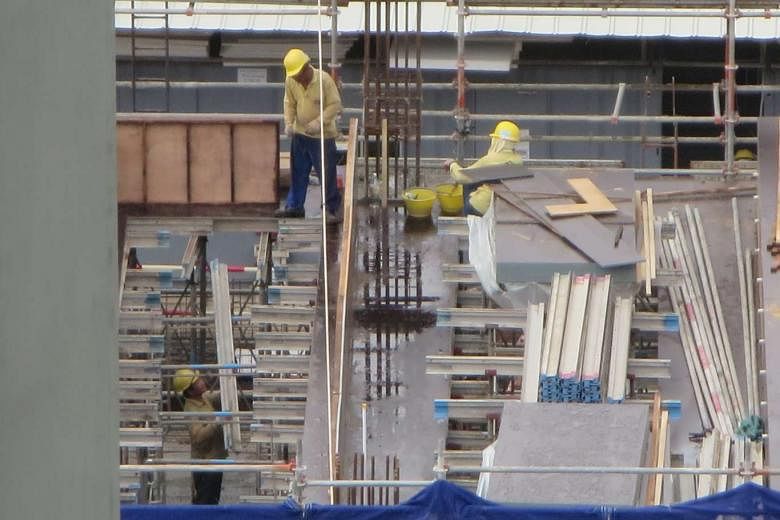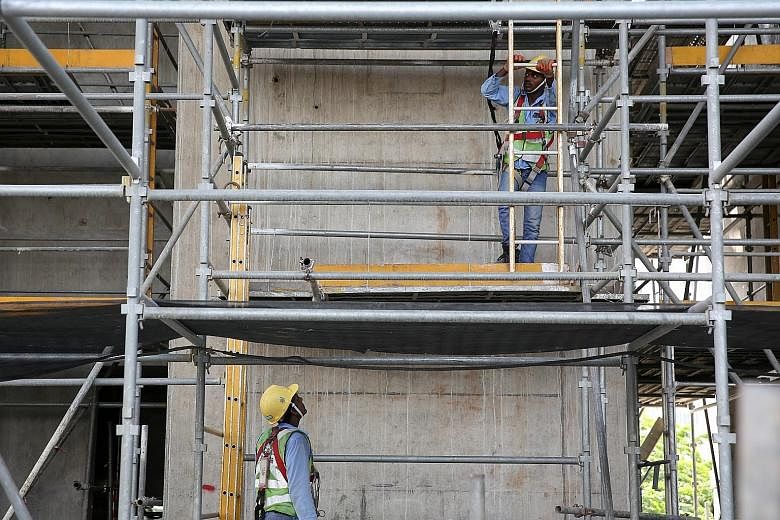Three days before he was to fly home for his wedding, Mr Mohan Suresh fell 14 storeys to his death.
On the morning of March 31, the 29-year-old plumber from India decided to check on some pipes on the roof of an HDB block in Jalan Damai, which he had fixed the day before.
He did not put on the safety harness and helmet lying in a storeroom 12 minutes' walk away, a coroner's finding on Sept 23 noted.
Perhaps he thought they were too far away. Perhaps it never crossed his mind to put them on. He had gone without them before. It had been fine. An hour later, his sandals lay empty on a ledge, next to a pipe which he had perhaps stretched a little too far to reach. He was found on the ground 45m below.
Mr Mohan never got to be a husband. He became a statistic.
He was one of the 55 people who died at work this year so far.
The rise in workplace deaths saw Manpower Minister Lim Swee Say warn last month that the fatality rate is likely to hit 2.2 per 100,000 workers this year.
Singapore had some success in bringing this down from 2.8 in 2008, when Prime Minister Lee Hsien Loong called for it to be pared to 1.8 within 10 years. In 2004, it had been a dire 4.9.
Singapore met the goal of 1.8 four years early in 2014, but this was short-lived. The rate crept up again to 1.9 last year, with 66 fatalities.
Compared to other countries, Singapore fared better than the United States, which had a rate of 3.3 in 2014. However, it lagged behind Australia at 1.61 in 2014, and the United Kingdom, which had a rate of 0.46 from April 2014 to March last year.
The construction sector had the highest casualty rate with 20 deaths.
Of the others, five occurred in marine, six in manufacturing, nine in the transport and storage sector, and 15 in other workplaces.


The total number of accidents at work also rose in the first half of the year to 6,149 injuries, up from 6,009 in the same period last year.
Said a Ministry of Manpower (MOM) spokesman: "Our analysis of the construction workplace fatalities indicates systemic lapses, workers' competency and absence of ownership as key drivers of the deteriorating situation in the construction sector."
GETTING THE MESSAGE OUT
Walk through a construction site and a barrage of hazards stands out even to the untrained eye.
Sharp lengths of metal protrude across paths. Workers pick their way among them, some in slippers, some checking their phones. Overhead, their colleagues clamber up and down scaffolding. Not all wear harnesses. Not all of those with harnesses have lifelines to hook onto.
Falls from height remain the most common cause of workplace death here, with 11 such deaths in the first half of the year.
Workers have died from other factors too - struck by falling objects, rolled into by trucks and forklifts.
The most recent death at work was unusual. Underwater World Singapore head diver Philip Chan, 62, died last Tuesday when a stingray he was handling pierced his lung with its tail. It is believed to be the first incident of its kind here.
The one thing all these deaths have in common, said National Trades Union Congress (NTUC) assistant secretary-general Patrick Tay, is that they were preventable.
Mr Tay, an MP for West Coast GRC, said top-down enforcement can go only so far: "Everyone along the value chain has to play his part. Leaders of organisations need to take ownership. Supervisors need to lead by example. And workers on the ground cannot be complacent, they must be proactive."

The Workplace Safety and Health Institute (WSHI) last month released a study on the beleaguered construction sector. It found that of 33 construction deaths between June last year and this May, nine in 10 deaths were due to unsafe behaviour by workers - such as not wearing protective gear, for instance.
Singapore Institution of Safety Officers president Bernard Soh said there are workers who cut corners with safety because it is convenient or they are distracted, especially given the prevalence of smartphones in the workplace.
But he is more worried about foreign workers for whom English is not a first language, who may not understand safety requirements. He said: "They will listen to what the supervisor wants them to do. I am concerned the supervisor may ask them to do something that is risky, and they may not realise it."
The Workplace Safety and Health Council (WSHC) this June launched an Awareness Booster Campaign, with pictogram posters teaching workers how to prevent injuries.
They are translated into Chinese, Tamil and Bengali, and distributed through channels such as dormitories, worksites and roadshows.
Older workers are another group the WSHC wants employers to pay attention to, with 18 per cent of accidents in the first half of the year happening to those aged 55 and above.
On Jan 14, an elderly cleaner sweeping leaves fell off a 1m-high planter wall and hit his head. He later died from his injuries.
Risks to older workers' health could be avoided, the WSHC said, if employers redesign tasks and equipment - like better lighting for visual tasks, or reducing physical workloads through mechanical aids.
WHY MESSAGE ISN'T HEEDED
But whether companies heed the call for safety is another matter.
The WSHI study on construction deaths also showed that nearly nine in 10 were due to companies failing to adequately manage risks. Some cut corners by neglecting to do risk assessments or withholding lifelines for workers' safety harnesses.
Contractors said it is tough to keep up standards in a cut-throat industry, where they have to undercut tender bids and rush to meet project deadlines in order to get by.
Singapore Contractors Association president Kenneth Loo said: "The economic situation is very challenging. Having gone through a period when growth in the industry was unprecedented, we are now having the reverse. Since the property market slowed down about two years ago, a lot of firms have been fighting for survival."
Struggling firms have been strapped ever since the MOM stiffened penalties in May by raising the minimum duration of a stop-work order from two to three weeks.
-
Report a lapse via MOM's app
Spot a workplace safety lapse? Snap a photo and send it to free mobile app Snap@MOM.
The app by the Ministry of Manpower will send your feedback to the company occupying the site if it has subscribed to the service, so it can then take action. Companies which have not subscribed will be alerted to follow up on the issue. You will get an acknowledgement through the app when the workplace occupier has acted on your report.
During such an order, companies cannot do any work until safety issues are rectified.
This drives up costs as they continue to pay workers and may face fines from developers if they miss deadlines.
Since May, 52 extended stop- work orders have been issued, each lasting an average of four weeks as companies also had to send their workers for refresher training.
Also in May, the MOM introduced the Safety Compliance Assistance Visits Plus (SCAV+). The programme offers free site assessments by certified WSH professionals to identify safety lapses, and 142 companies have made use of it.
The Government is also incentivising employers who put safety first. From this month, those who hire foreign construction workers trained in specific safety standards will have levies reduced from $650 to $300, and get to keep these workers for up to 22 years, up from 10 previously.
Contractors wonder if more can be done to support those who put in extra effort. Wee Chwee Huat Scaffolding and Construction operations manager V. Manimaran suggests making it compulsory for a chunk of each project budget - at least 5 per cent - to be set aside for safety. "This would even the playing field for companies which already invest in safety," he said.
The MOM noted that the number of construction fatalities per month has declined from an average of three between January and May to two between June and September. Its spokesman said: "While the drop in fatalities for the third quarter does indicate that our enforcement and outreach activities are taking effect, nonetheless, every fatality is still one too many."
MORE MUST BE DONE
Those who die at work include Singaporeans and foreigners alike. But the bulk of the workforce in high-risk sectors such as construction and marine are foreigners from countries such as China, India, Bangladesh and Myanmar.
The MOM does not release information on the nationalities of individual victims, but has said that on average, two-thirds of workers who have died in fatal workplace accidents are foreigners.
SIM University labour economist Walter Theseira said this predominantly migrant workforce upends the economic theory that an employer has to pay workers more to get them to take up an undesirable job with higher risk.
"Here, these dangerous jobs are held mostly by foreigners who are not paid a lot and come from countries where workplace standards are significantly lower," he said.
"The economic incentives for employers to enforce safety are not there. So we have categories of workers in Singapore where the value of their lives is not as high as it should be. Is this because they come from countries where the value of their lives is lower, or because we, as a society, don't treat them the way we would if they were Singaporean?"
Migrant worker groups have called for more to be done to address what they view as the root causes of unsafe worker behaviour - low wages, high debts, a fear of speaking out against employers who could send them home at the drop of a hat.
Transient Workers Count Too committee member Debbie Fordyce said workers are often in debt because of high recruitment fees they pay to agents before they even come to Singapore and "we have to get rid of these".
Another problem is the amount of overtime some workers do, to earn more or due to employers rushing to meet deadlines. Ms Fordyce has heard of men working 15 hours a day, seven days a week, that "causes chronic fatigue, which leads to impairment of judgment and inattention to detail".
Under the Employment Act, workers commonly work up to nine hours a day. They should not work more than 12 hours except in emergency circumstances.
Social work executive Jevon Ng of the Humanitarian Organisation for Migration Economics said he often hears from workers that they are not given proper equipment, and cables are the wrong length for the height they must work at. Some even have to buy their own safety equipment. But workers are reluctant to voice concerns about safety hazards and near misses, as they fear being repatriated for doing so.
One way for the public to help out is the mobile app Snap@ MOM, through which anyone can anonymously report safety lapses. Since April, the MOM has seen a 40 per cent rise in reports on lapses via the app, with an average of 70 reports a month.
In one case, a photo taken of an unsafe worksite landed the contractor in question with a stop-work order for work at height and scaffolding activities, and fines of $7,500. The photo showed open edges at height not guarded by effective guard-rails or barriers to prevent falls.
Singapore's workplace safety will be in the spotlight when it hosts the 21st World Congress on Safety and Health at Work next September. It remains to be seen whether the workplace fatality rate will fall before then.
Said NTUC's Mr Tay: "When it comes to safety, it's not a matter of trying, but doing. There can be no compromise."



